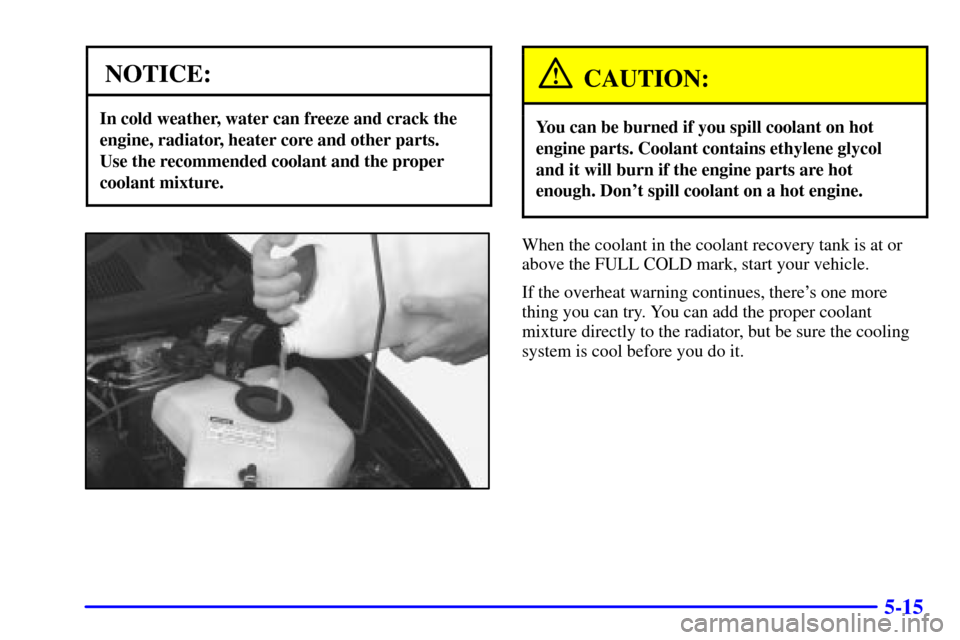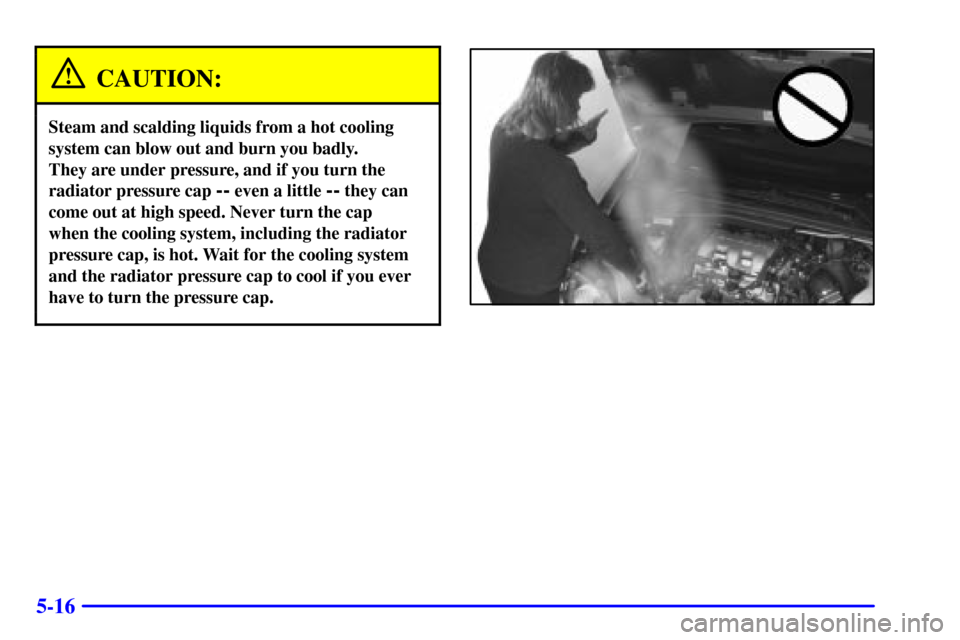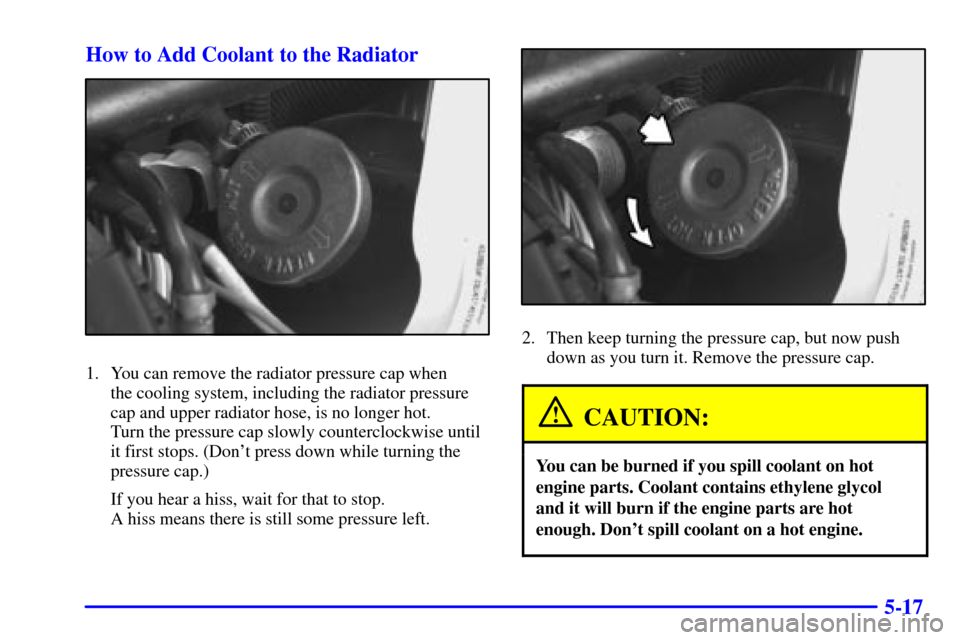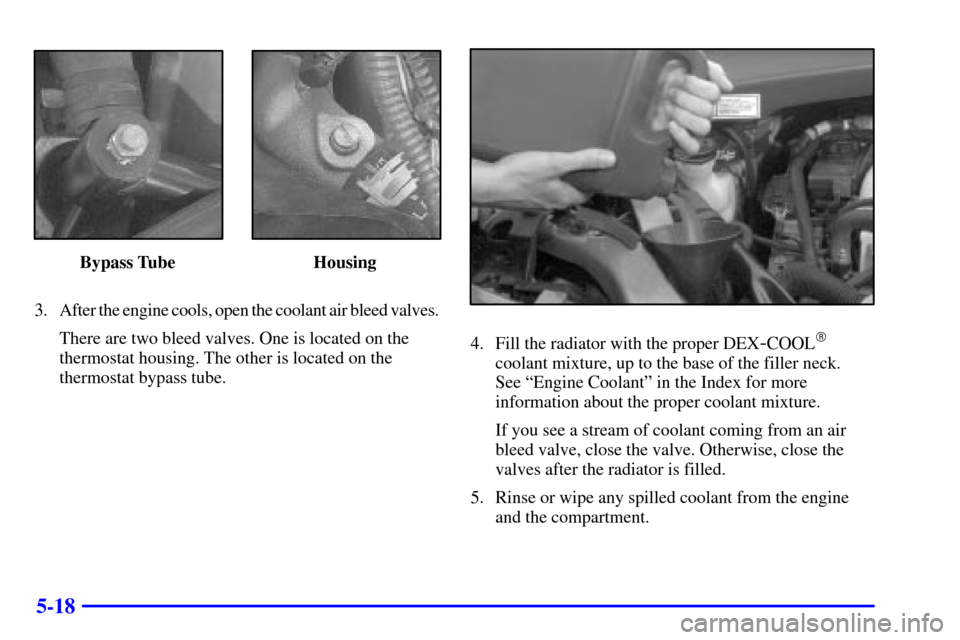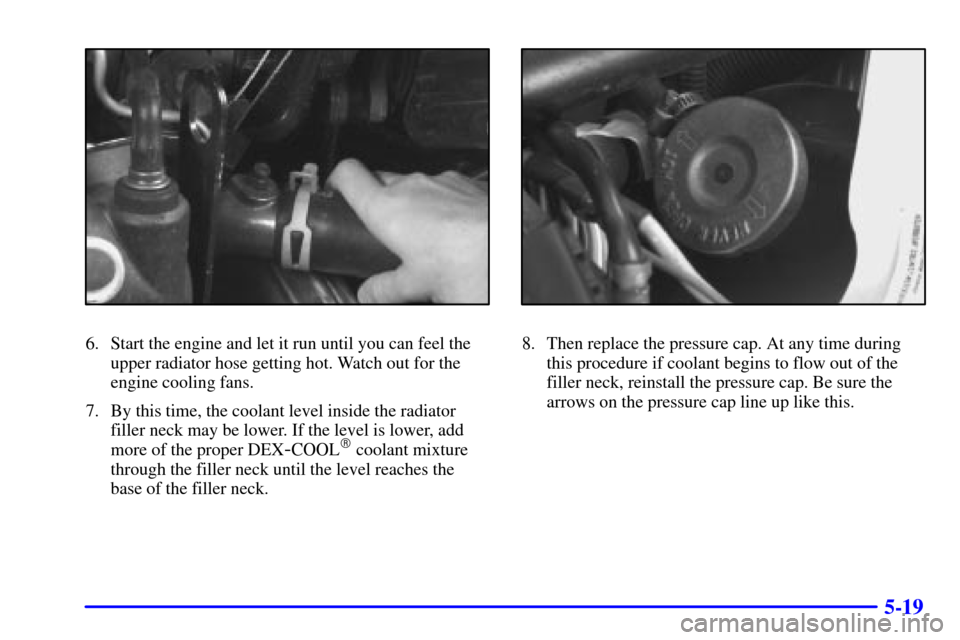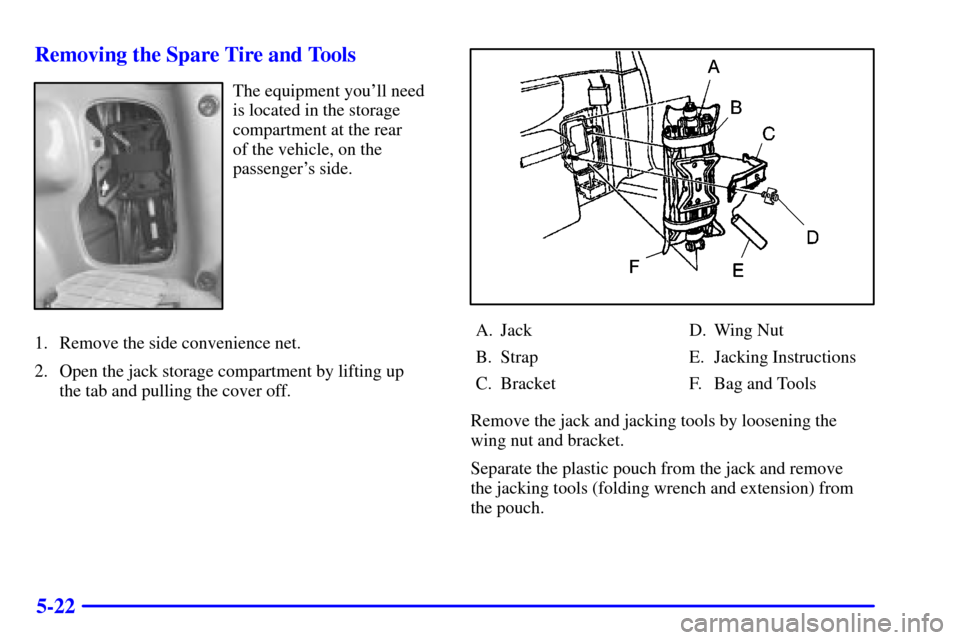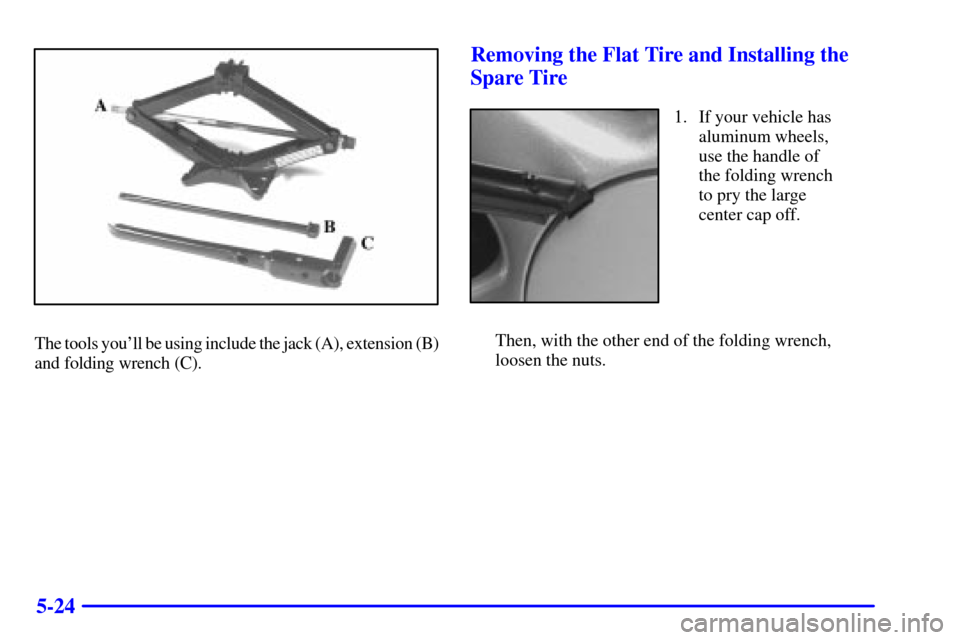Oldsmobile Silhouette 2001 Owner's Manuals
Silhouette 2001
Oldsmobile
Oldsmobile
https://www.carmanualsonline.info/img/31/9589/w960_9589-0.png
Oldsmobile Silhouette 2001 Owner's Manuals
Trending: high beam, cooling, parking brake, keyless entry, odometer, 2001 oldsmobile silhouette, oil pressure
Page 311 of 436
5-15
NOTICE:
In cold weather, water can freeze and crack the
engine, radiator, heater core and other parts.
Use the recommended coolant and the proper
coolant mixture.
CAUTION:
You can be burned if you spill coolant on hot
engine parts. Coolant contains ethylene glycol
and it will burn if the engine parts are hot
enough. Don't spill coolant on a hot engine.
When the coolant in the coolant recovery tank is at or
above the FULL COLD mark, start your vehicle.
If the overheat warning continues, there's one more
thing you can try. You can add the proper coolant
mixture directly to the radiator, but be sure the cooling
system is cool before you do it.
Page 312 of 436
5-16
CAUTION:
Steam and scalding liquids from a hot cooling
system can blow out and burn you badly.
They are under pressure, and if you turn the
radiator pressure cap
-- even a little -- they can
come out at high speed. Never turn the cap
when the cooling system, including the radiator
pressure cap, is hot. Wait for the cooling system
and the radiator pressure cap to cool if you ever
have to turn the pressure cap.
Page 313 of 436
5-17 How to Add Coolant to the Radiator
1. You can remove the radiator pressure cap when
the cooling system, including the radiator pressure
cap and upper radiator hose, is no longer hot.
Turn the pressure cap slowly counterclockwise until
it first stops. (Don't press down while turning the
pressure cap.)
If you hear a hiss, wait for that to stop.
A hiss means there is still some pressure left.
2. Then keep turning the pressure cap, but now push
down as you turn it. Remove the pressure cap.
CAUTION:
You can be burned if you spill coolant on hot
engine parts. Coolant contains ethylene glycol
and it will burn if the engine parts are hot
enough. Don't spill coolant on a hot engine.
Page 314 of 436
5-18
Bypass Tube Housing
3. After the engine cools, open the coolant air bleed valves.
There are two bleed valves. One is located on the
thermostat housing. The other is located on the
thermostat bypass tube.
4. Fill the radiator with the proper DEX-COOL�
coolant mixture, up to the base of the filler neck.
See ªEngine Coolantº in the Index for more
information about the proper coolant mixture.
If you see a stream of coolant coming from an air
bleed valve, close the valve. Otherwise, close the
valves after the radiator is filled.
5. Rinse or wipe any spilled coolant from the engine
and the compartment.
Page 315 of 436
5-19
6. Start the engine and let it run until you can feel the
upper radiator hose getting hot. Watch out for the
engine cooling fans.
7. By this time, the coolant level inside the radiator
filler neck may be lower. If the level is lower, add
more of the proper DEX
-COOL� coolant mixture
through the filler neck until the level reaches the
base of the filler neck.
8. Then replace the pressure cap. At any time during
this procedure if coolant begins to flow out of the
filler neck, reinstall the pressure cap. Be sure the
arrows on the pressure cap line up like this.
Page 316 of 436
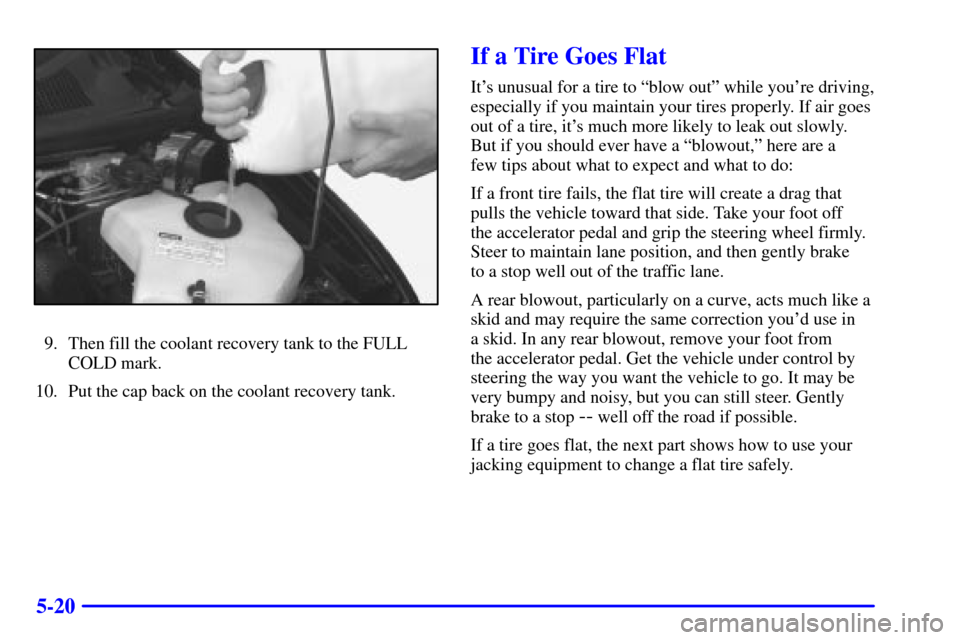
5-20
9. Then fill the coolant recovery tank to the FULL
COLD mark.
10. Put the cap back on the coolant recovery tank.
If a Tire Goes Flat
It's unusual for a tire to ªblow outº while you're driving,
especially if you maintain your tires properly. If air goes
out of a tire, it's much more likely to leak out slowly.
But if you should ever have a ªblowout,º here are a
few tips about what to expect and what to do:
If a front tire fails, the flat tire will create a drag that
pulls the vehicle toward that side. Take your foot off
the accelerator pedal and grip the steering wheel firmly.
Steer to maintain lane position, and then gently brake
to a stop well out of the traffic lane.
A rear blowout, particularly on a curve, acts much like a
skid and may require the same correction you'd use in
a skid. In any rear blowout, remove your foot from
the accelerator pedal. Get the vehicle under control by
steering the way you want the vehicle to go. It may be
very bumpy and noisy, but you can still steer. Gently
brake to a stop
-- well off the road if possible.
If a tire goes flat, the next part shows how to use your
jacking equipment to change a flat tire safely.
Page 317 of 436
5-21
Changing a Flat Tire
If a tire goes flat, avoid further tire and wheel damage
by driving slowly to a level place. Turn on your hazard
warning flashers.
CAUTION:
Changing a tire can cause an injury. The vehicle
can slip off the jack and roll over you or other
people. You and they could be badly injured.
Find a level place to change your tire. To help
prevent the vehicle from moving:
1. Set the parking brake firmly.
2. Put the shift lever in PARK (P).
3. Turn off the engine.
To be even more certain the vehicle won't move,
you can put blocks at the front and rear of the
tire farthest away from the one being changed.
That would be the tire on the other side of the
vehicle, at the opposite end.
The following steps will tell you how to use the jack and
change a tire.
Page 318 of 436
5-22 Removing the Spare Tire and Tools
The equipment you'll need
is located in the storage
compartment at the rear
of the vehicle, on the
passenger's side.
1. Remove the side convenience net.
2. Open the jack storage compartment by lifting up
the tab and pulling the cover off.
A. Jack
B. Strap
C. BracketD. Wing Nut
E. Jacking Instructions
F. Bag and Tools
Remove the jack and jacking tools by loosening the
wing nut and bracket.
Separate the plastic pouch from the jack and remove
the jacking tools (folding wrench and extension) from
the pouch.
Page 319 of 436
5-23
A. Hoist Shaft
B. Hoist Assembly
C. Retainer
D. Spare TireE. Extension
(Chisel End)
F. Folding Wrench
The compact spare tire is located under the vehicle,
ahead of the rear bumper. (See ªCompact Spare Tireº
later in this section for more information about the
compact spare.) Attach the folding wrench to the
extension and insert the chisel end on an angle through
the hole in the rear bumper and into the hoist shaft.Then, turn the folding wrench counterclockwise to
lower the spare tire to the ground. Continue to turn the
wrench so the spare tire can be pulled out from under
the vehicle.
Tilt the retainer at the end of the cable so it can be pulled
up through the wheel opening.
Page 320 of 436
5-24
The tools you'll be using include the jack (A), extension (B)
and folding wrench (C).
Removing the Flat Tire and Installing the
Spare Tire
1. If your vehicle has
aluminum wheels,
use the handle of
the folding wrench
to pry the large
center cap off.
Then, with the other end of the folding wrench,
loosen the nuts.
Trending: keyless entry, child lock, relay, check engine, sensor, air suspension, recommended oil
